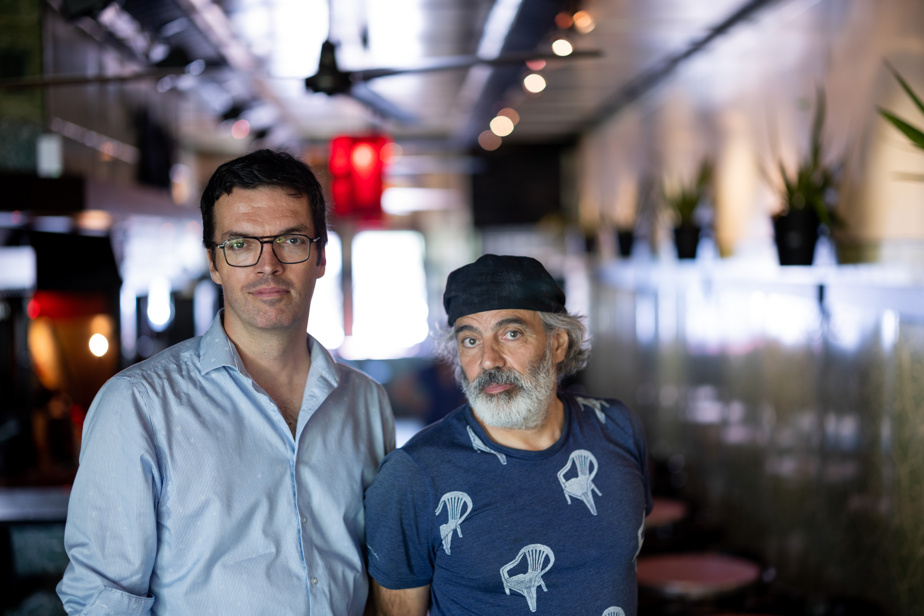After the poetry deployed in The torrent (2012), based on the short story by Anne Hébert, and The little girl who loved matches too much (2017), based on the novel by Gaétan Soucy, Simon Lavoie returns to a more radical and demanding proposal.
“If I had refined this script for 10 years, tried to obtain financing of 10 million, I would not have made this film. It had to be something instinctive, intuitive, for which I was going to bring together people ready for anything, like Jean-François Casabonne,” summarizes the director.
“For an actor or actress, what Simon offers is a fantastic playground because in this film in particular, it’s an incursion into a space where you can explore your interiority, go into areas that you know, but in a more draconian way,” says the actor, happy to have worked again with the filmmaker who had directed him in The Little Girl Who Loved Matches Too Much.
Discussing the filmmaker’s achievements with Mathieu Denis, Laurentia (2011) and Those who make revolutions halfway have only dug their own graves. (2016), Melt transports us, like No trace (2021), in a not-so-distant future. While he borrowed from Bergman, Tarkovsky and Béla Tarr in his previous film, this time, the director turns resolutely to Pierre Falardeau, Pierre Perrault… and David Cronenberg.
“There were a lot of cinematic desires that had been going through my mind for years,” says Simon Lavoie. “At the beginning, there was this old idea that I had, which goes back a long, long way with my brother. We imagined stories where a worm traveled from one cell to another.”
The idea that overshadowed all these ideas for cinema was the urgency of what I felt, like a haunting, a worry that nations are not eternal and that we are perhaps in a phase of decline, of slippage, of erosion of French, of our cultural traits.
Simon Lavoie, filmmaker
“What Simon is proposing is daring, it’s a strange, unusual territory,” believes Jean-François Casabonne. This film is a mixture of genres that we don’t often see here. What really interested me in this very particular film is that it highlights the entire construction of memory, how we bring it to life, how it can disappear and then be reborn. This angle is rarely addressed in our cinematography, but Simon dares to go there and I, as an actor, put myself at his service. »
Registration number 973
At the same time prison drama, political fable, anticipation film, essay film and horror film set in a Quebec where only impoverished English is spoken, Melt features prisoner number 973 (Casabonne) who, with the complicity of a housekeeper (Monique Gosselin), helps other political prisoners (Louise Laprade, Guy Thauvette, Luc Morissette, Fayolle Jean and Pierre Curzi) escape life sentences thanks to the tapeworm he carries inside him. In the process, he thus collects the memory of the Quebec people.
“Horror cinema appeals a lot to the senses, both in sound design and in physical horror,” explains Simon Lavoie. “In Cronenberg’s cinema, we find this haunting of the parasite, of excrescence; it’s something universal.”
I instinctively felt that there was a metaphorical link to be made between this creature inside us and this kind of somewhat national foundation of this psyche, of this soul of Quebec that we have within us because we are the fruit of a historical conscience.
Simon Lavoie, filmmaker
“My character becomes the receptacle of this memory. I was very attracted by the metaphor of the worm because basically, if we place ourselves at a height and look at this great founding artery that is our river, we can compare it to a poetic worm,” says Jean-François Casabonne.
Supported by texts by Anne Hébert, Hubert Aquin, Fernand Dumont and other authors who thought and defined Quebec, Melt stands out for its way of carrying within itself the memory of great Quebec filmmakers. Thus, this prison drama was filmed in Sorel prison like the Orders (1974), by Michel Brault.
“It was fantastic to play in this venue which is now a factory jarreveals the actor. Simon also filmed with old leftover 16mm reels, which give an old-fashioned look to the film, which becomes like a kind of Polaroid of a past that projects itself into the future. It’s clever, the idea he had to create this procession of memories by bringing together the whole panoply of actors and actresses, who are treasures… Ferraris!
“In this film, ambiguous, I admit, we see that the elderly prisoners are the watchdogs of this culture that must be preserved, like the copyist monks in the Middle Ages,” the director notes. “We didn’t try to film in the same cells, but the fact of filming there was coherent in this whole network of visual, thematic, semiotic and symbolic elements.”
Furthermore, Simon Lavoie adds that anyone who has chosen Quebec as a territory can in turn be “the depositary of this historical consciousness, this culture and this language that must be cherished and preserved”.
“It’s our way out of Quebec,” believes the filmmaker. For me, nationalism is eminently positive, vital and inclusive. The term, unfortunately, has become pejorative, but in Quebec, it does not have the same definition as in Europe after the Second World War, as in Trump’s America. It is this nationalism that created the Quiet Revolution, modern Quebec. I think we must assume it and claim it without embarrassment. »
In theaters June 28
